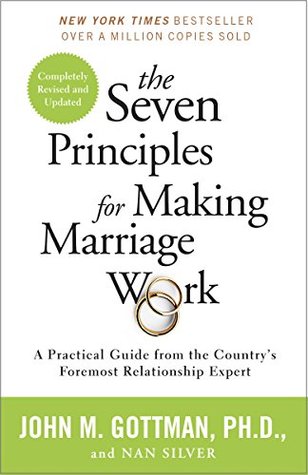More on this book
Community
Kindle Notes & Highlights
Read between
October 19, 2019 - February 1, 2021
What can make a marriage work is surprisingly simple. Happily married couples aren’t smarter, richer, or more psychologically astute than others. But in their day-to-day lives, they have hit upon a dynamic that keeps their negative thoughts and feelings about each other (which all couples have) from overwhelming their positive ones. Rather than creating a climate of disagreement and resistance, they embrace each other’s needs. When addressing a partner’s request, their motto tends to be a helpful “Yes, and …” rather than “Yes, but …”
One of the saddest reasons a marriage dies is that neither spouse recognizes its value until it is too late.
Most therapists got very high customer-satisfaction marks—except for the marital ones, who received very poor ratings.
The point is that neuroses don’t have to ruin a marriage. If you can accommodate each other’s “crazy” side and handle it with caring, affection, and respect, your marriage can thrive.
At the heart of the Seven Principles approach is the simple truth that happy marriages are based on a deep friendship. By this I mean a mutual respect for and enjoyment of each other’s company.
Most of the couples who participate in our workshops are relieved to hear that almost everybody messes up during marital conflict. What matters is whether their repairs succeed.
Like many complaints, it has three parts: (1) Here’s how I feel (“I’m really angry”); (2) About a very specific situation (“you didn’t sweep last night”); (3) And here’s what I need/want/prefer (“Could you do it now?”).
Since marital confrontation that activates vigilance takes a greater physical toll on the male, it’s no surprise that men are more likely than women to attempt to avoid it.
You can see the seeds of trouble in (1) what partners actually say to each other (the prevalence of harsh start-up, the four horsemen, and the unwillingness to accept influence), (2) the failure of their repair attempts, (3) physiological reactions (flooding), or (4) pervasive negative thoughts about their marriage.
the best test of whether a couple still have a functioning fondness and admiration system is usually how they view their past. If a marriage is troubled, asking the couple about the current state of affairs is not likely to elicit much mutual praise. But query them about the past and you can often detect embers of positive feelings.
But developing a positive habit doesn’t “sugarcoat” a relationship. Instead it resets it to a more realistic perspective.
Cherishing is a habit of mind in which, when you are separated during the course of the day, you maximize thoughts of your partner’s positive qualities and minimize thoughts of negative ones.
In our six-year follow-up of newlyweds, we found that couples who remained married had turned toward their partner’s bids an average of 86 percent of the time in the Love Lab, while those who ended up divorced had averaged only 33 percent.
“Reunite at the end of the day and talk about how it went.”
After years of studying couples in the lab and working with them directly, it has become clear to me that happy couples live by the credo “When you are in pain, the world stops and I listen.”
Psychologist Dan Wile said it best in his book After the Honeymoon: “When choosing a long-term partner … you will inevitably be choosing a particular set of unsolvable problems that you’ll be grappling with for the next ten, twenty, or fifty years.”
My fifth principle entails the following steps: 1. Soften your start-up. 2. Learn to make and receive repair attempts. 3. Soothe yourself and each other. 4. Compromise. 5. Process any grievances so that they don’t linger.
The best soft start-up has four parts: (1) “I share some responsibility for this …” (2) Here’s how I feel … (3) about a specific situation and … (4) here’s what I need … (positive need, not what you don’t need).
If your heart rate exceeds 100 beats per minute (80 if you’re an athlete), you won’t be able to hear what your spouse is trying to tell you no matter how hard you try. Take a twenty-minute break before continuing.
The problem is that the less clear you are about what you want, the less likely you are to get it.
But a culture can also be created by just two people who have agreed to share their lives. In essence, each couple and each family create its own microculture. And like other cultures, these small units have their customs (like Sunday dinner out), rituals (like a champagne toast after the birth of each baby), and myths—the stories the couple tell themselves (whether true, false, or embellished) that explain their sense of what their marriage is like and what it means to be part of their group.
All criticism is painful. Unlike complaints—specific requests for change—criticism doesn’t make a marriage better. It inevitably makes it worse.


